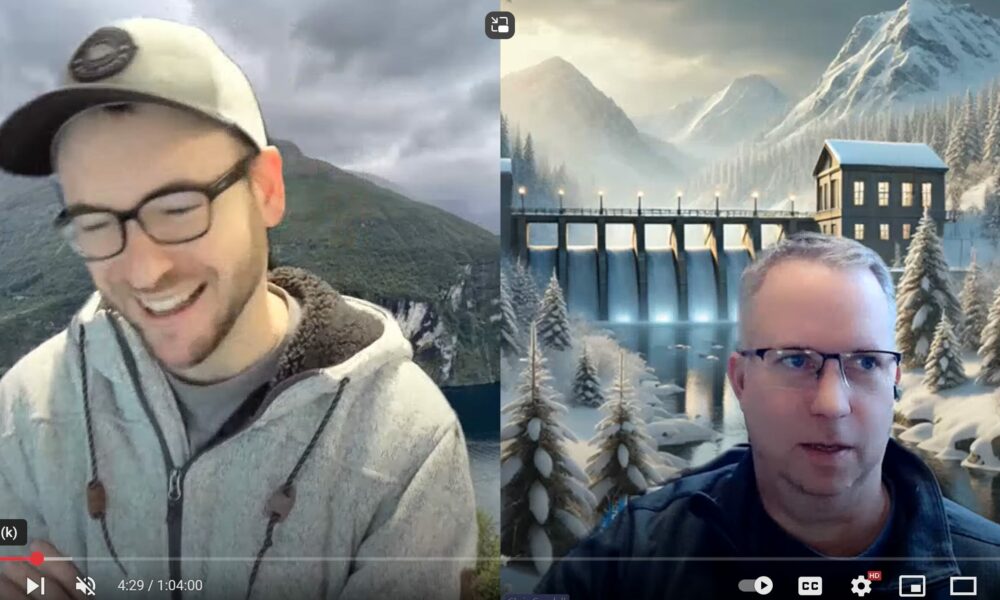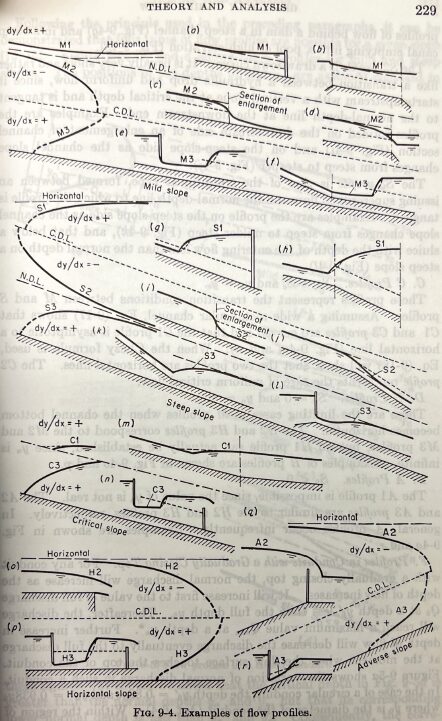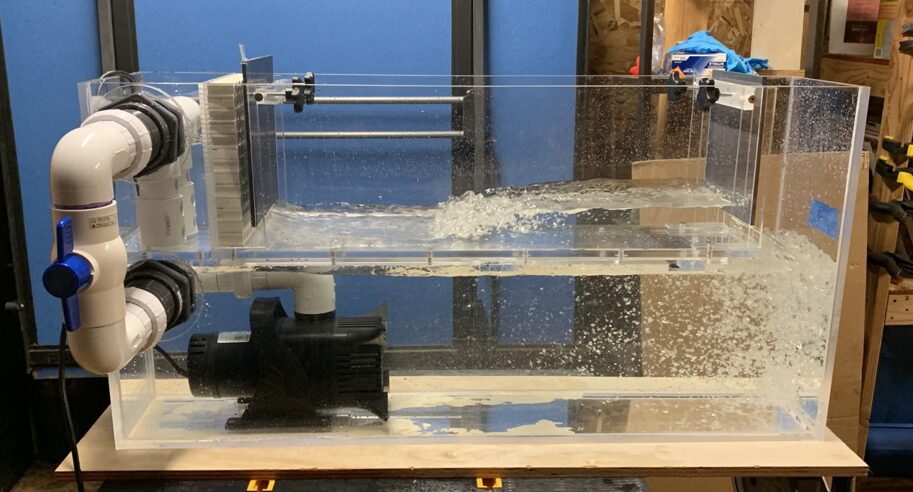
Full Momentum Episode 37: All Things Gates
Gates play a crucial role in hydraulic modeling, impacting water flow, flood control, and dam operations.
Chris Goodell, P.E., BC.WRE
Kleinschmidt Associates
Copywrite © 2024
Ven Te Chow’s book “Open Channel Hydraulics” is arguably the gold-standard book for hydraulic engineers-especially those of us who model open channel flow. The first publication of “Open Channel Hydraulics” came out in 1959, but even 65 years later, this book still holds up. I remember as a brand new hydraulic engineer-in-training, right out of college, discovering Chow’s diagrams of gradually varied flow water surface profiles, showing how water flows through channels under steep, mild, critical, horizontal, and even adverse slopes. These profiles illustrate where the water surface elevation would be along a channel in relation to normal and critical depth, the curve in the profile you would expect to see, and they were conveniently labeled “M1”, “M2”, “M3”, “S1, “S2”, etc for easy reference. The letter corresponds to the type of slope (mild, steep, etc.) and the number corresponds to where the water surface is relative to normal and critical depths. They are great visuals to help us predict what flow would look like under a variety of open channel flow conditions.

And to see these profiles replicated in real situations and in flume demonstrations really cemented the benefit of these visuals. Even today, I still recall and reference Chow’s profiles when reviewing and evaluating HEC-RAS model results. I should note that Chow credits Emmanuel-Joseph Boudin for first classifying and describing the different open channel flow profiles (M. Boudin, “De l’axe hydraulique des cours d’eau contenus dans un lit prismatique et des dispositifs réalisant, en pratique, ses formes diverses” The flow profiles of water in a prismatic channel and actual dispositions in various forms, Annales des travaux puliques de Belgique, Brussels, vol. 20, pp. 397-555, 1681-1862.)
Having a scaled flume model is another great way to demonstrate gradually varied profiles. If you’re lucky enough to have access to a flume, you know what I’m talking about. Here’s a photo of the Qual-E Flume that Zach Taylor and I built about a year ago (OK, mostly designed and built by Zach, but I did turn a few wrenches for him).

Notice the “M3” curve coming out of the gate on the upstream side, followed by a hydraulic jump transition to an “M1” curve, very similar to Chow profile (e) shown in Figure 1. However, not everyone has a flume to play around with. And even with a flume, it can take some time to change the flume slope, adjust the discharge, add in structures, etc. etc.
I recently taught an HEC-RAS class in Oslo, Norway. Great class and great people. As always, I thoroughly enjoy all things Norway. If you haven’t been and you get a chance to visit Norway, I highly recommend it. Halvor Kjærås was an attendee of this recent HEC-RAS course. He pulled me aside during one of the breaks to show me a project he’s working on. Needless to say, I was very impressed and immediately saw the benefit of his work to our river modeling community. Halvor has developed a series of “virtual” flume models. They are nice visuals of the same thing Chow presented in his book, but so much more. They’re interactive, so you can change things like slope, roughness, gate openings, grade breaks, discharge, downstream controls, etc., etc., all the while seeing how the water surface profile relates to normal and critical depth. And the changes in the water surface profiles happen in real-time. As Halvor puts it, these are “really useful for explaining hydraulic principles and as a hands-on digital lab.” I couldn’t agree more!
Here are just a couple of examples.
Figure 3. Virtual Flume Animation – “Hydraulic Control”, Courtesy Halvor Kjærås
Figure 4. Virtual Flume Animation – “Flow Over a Step”, Courtesy Halvor Kjærås
These interactive virtual flume demos solve the gradually varied flow equations (same as HEC-RAS 1D) for steady flow in a rectangular channel in real-time as you make adjustments. Halvor wrote all of these using JavaScript, so they’re all available through any web browser. Halvor says “The program is designed to illustrate hydraulic principles and build intuition rather than provide exact numerical values. I encourage users to experiment with the demos to see how water reacts to different conditions. Perhaps you even learn something new.” He’s still developing these and welcomes feedback and suggestions. You can contact Halvor with constructive feedback at halvorkjaras@gmail.com, but keep in mind this is a spare-time project for him.
Here are all the virtual flumes that Halvor has available. Have fun!
Normal depth
https://ironigardinen.net/hydraulics/gvf/normalDepth.html
Critical depth
https://ironigardinen.net/hydraulics/gvf/criticalDepth.html
Gradually varied flow
https://www.ironigardinen.net/hydraulics/gvf/gradually.html
Hydraulic control
https://ironigardinen.net/hydraulics/gvf/control.html
Hydraulic jump
https://ironigardinen.net/hydraulics/gvf/hydraulicjump.html
Flow over a step
https://ironigardinen.net/hydraulics/gvf/step.html
Location of control section (compound systems)
https://ironigardinen.net/hydraulics/gvf/controlsection.html
Sluice gate
https://ironigardinen.net/hydraulics/gvf/sluicegate.html
Choking
https://ironigardinen.net/hydraulics/gvf/choking.html
Drop
https://ironigardinen.net/hydraulics/gvf/drop.html
Parshall flume
https://ironigardinen.net/hydraulics/gvf/parshallflume.html
Rating curve
https://ironigardinen.net/hydraulics/gvf/ratingCurve.html
Spillway submergence (Norwegian)
https://ironigardinen.net/hydraulics/gvf/overlopskapasitet.html
Side channel spillway (Norwegian)
https://ironigardinen.net/hydraulics/gvf/samlekanal.html
A little bit about Halvor Kjærås:
I graduated from the Norwegian University of Science and Technology (NTNU) in 2012 with a Master of Science degree in river hydraulics and civil engineering. I worked for six years as a consultant for Sweco, primarily designing and reassessing concrete and rockfill dams. However, my main interest was in hydraulics, and I seized the opportunity to pursue a PhD on hydraulic methods to improve downstream passage of migrating fish at hydropower intakes. Today I work at Norconsult, focusing almost solely on hydraulics, including inundation mapping, design of tunnel spillways, river restauration, and fish migration projects.
During my PhD work, my duties involved teaching the introductory course in hydromechanics for second-year students. From my observations, both from my students and my own learning experiences, I recognized the significant learning advantages offered by the hydraulic laboratory. Physically manipulating the water flow, bottom slope and the downstream depth provide immediate feedback , which builds intuition more effectively than both blackboard explanations, manual calculations, and HEC-RAS.
However, providing 200 students with access to a hydraulic lab is expensive, so I sought to find a digital solution. I was surprised to find no existing resources, so I decided to develop my own program. The program solves the gradually varied flow equations (the same equations used in HEC-RAS 1D) for steady flow in a rectangular channel . The water surface is calculated in real-time as users manipulate markers for water surface and gate openings and adjust the sliders controlling flow and roughness coefficients. I wrote the program in JavaScript so it can run natively in web browsers. As a self-taught programmer, I acknowledge there will be bugs.
The program is designed to illustrate hydraulic principles and build intuition rather than provide exact numerical values. I encourage users to experiment with the demos to see how water reacts to different conditions. Perhaps you even learn something new.
Comments
Add Your Comment